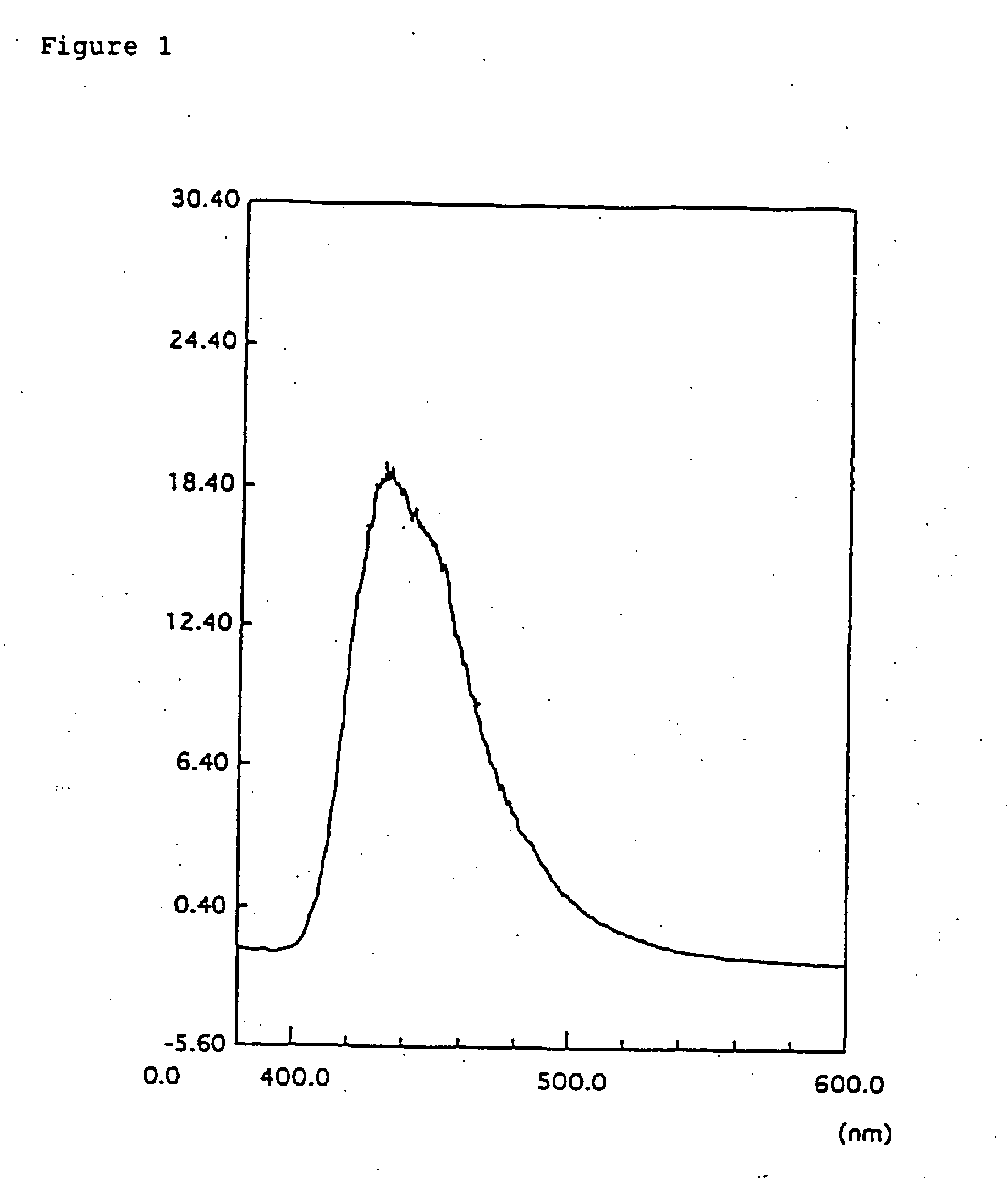Organic electroluminescence device and phenylenediamine derivative
- Summary
- Abstract
- Description
- Claims
- Application Information
AI Technical Summary
Benefits of technology
Problems solved by technology
Method used
Image
Examples
example 1
Synthesis of 4-Iodotriphenylamine
[0145] 125 g of triphenylamine (produced by Hiroshima Wako & Co., Ltd.) was dissolved in 5 L of ethanol by heating, to which 150 g of mercury oxide was added at 60° C., and then 100 g of iodine was gradually added. Thereafter, the reaction was conducted for 2 hours at a reflux temperature.
[0146] After the reaction, the system was filtered under hot, and the residue was washed with acetone. The filtrate was cooled, and crystals thus deposited were filtered out.
[0147] It was purified by using a column carrying silica gel with toluene as a developing solvent, so as to obtain 52 g of objective substance.
(Synthesis of PD-01)
[0148] 10 g of 4,4″-diamino-p-terphenylene (produced by Lancaster Synthesis, Ltd.), 20 g of 1-iodonaphthalene (produced by Hiroshima Wako & Co., Ltd.), 20 g of potassium carbonate, 1 g of copper powder and 100 ml of nitrobenzene were placed in a 300-ml three-neck flask, and were heated under stirring at 200° C. for 48 hours.
[014...
example 2
(Synthesis of PD-02)
[0153] 10 g of 9,10-diaminophenylanthracene (produced by Wakayama Seika Industries, Ltd.), 20 g of 1-iodonaphthalene (produced by Hiroshima Wako & Co., Ltd.), 20 g of potassium carbonate, 1 g of copper powder and 100 ml of nitrobenzene were placed in a 300-ml three-neck flask, and were heated under stirring at 200° C. for 48 hours.
[0154] After the reaction, inorganic matters were filtered out, and the solvents in the mother liquid were distilled off. The residue was purified by using a column carrying silica gel (C-200 produced by Hiroshima Wako & Co., Ltd.) with toluene as a developing solvent, so as to obtain 7.7 g of 9,10-bis(1-naphthylaminophenyl)anthracene.
[0155] 5 g thereof, 15 g of 4-iodotriphenylamine, 20 g of potassium carbonate, 1 g of copper powder and 100 ml of nitrobenzene were placed in a 300-ml three-neck flask, and were heated at 200° C. for 60 hours.
[0156] After the reaction, inorganic matters were filtered out, and the solvents in the mothe...
example 3
(Synthesis of PD-03)
[0158] 10 g of 4,4′-diaminodiphenylmethane (produced by Hiroshima Wako & Co., Ltd.), 20 g of 1-iodonaphthalene (produced by Hiroshima Wako & Co., Ltd.), 20 g of potassium carbonate, 1 g of copper powder and 100 ml of nitrobenzene were placed in a 300-ml three-neck flask, and were heated under stirring at 200° C. for 48 hours.
[0159] After the reaction, inorganic matters were filtered out, and the solvents in the mother liquid were distilled off. The residue was purified by using a column carrying silica gel (C-200 produced by Hiroshima Wako & Co., Ltd.) with toluene as a developing solvent, so as to obtain 9.6 g of bis(4-(naphthyl-1-yl)aminophenyl)methane.
[0160] 5 g thereof, 15 g of 4-iodotriphenylamine, 20 g of potassium carbonate, 1 g of copper powder and 100 ml of nitrobenzene were placed in a 300-ml three-neck flask, and were heated at 200° C. for 60 hours.
[0161] After the reaction, inorganic matters were filtered out, and the solvents in the mother liqui...
PUM
 Login to View More
Login to View More Abstract
Description
Claims
Application Information
 Login to View More
Login to View More - Generate Ideas
- Intellectual Property
- Life Sciences
- Materials
- Tech Scout
- Unparalleled Data Quality
- Higher Quality Content
- 60% Fewer Hallucinations
Browse by: Latest US Patents, China's latest patents, Technical Efficacy Thesaurus, Application Domain, Technology Topic, Popular Technical Reports.
© 2025 PatSnap. All rights reserved.Legal|Privacy policy|Modern Slavery Act Transparency Statement|Sitemap|About US| Contact US: help@patsnap.com



